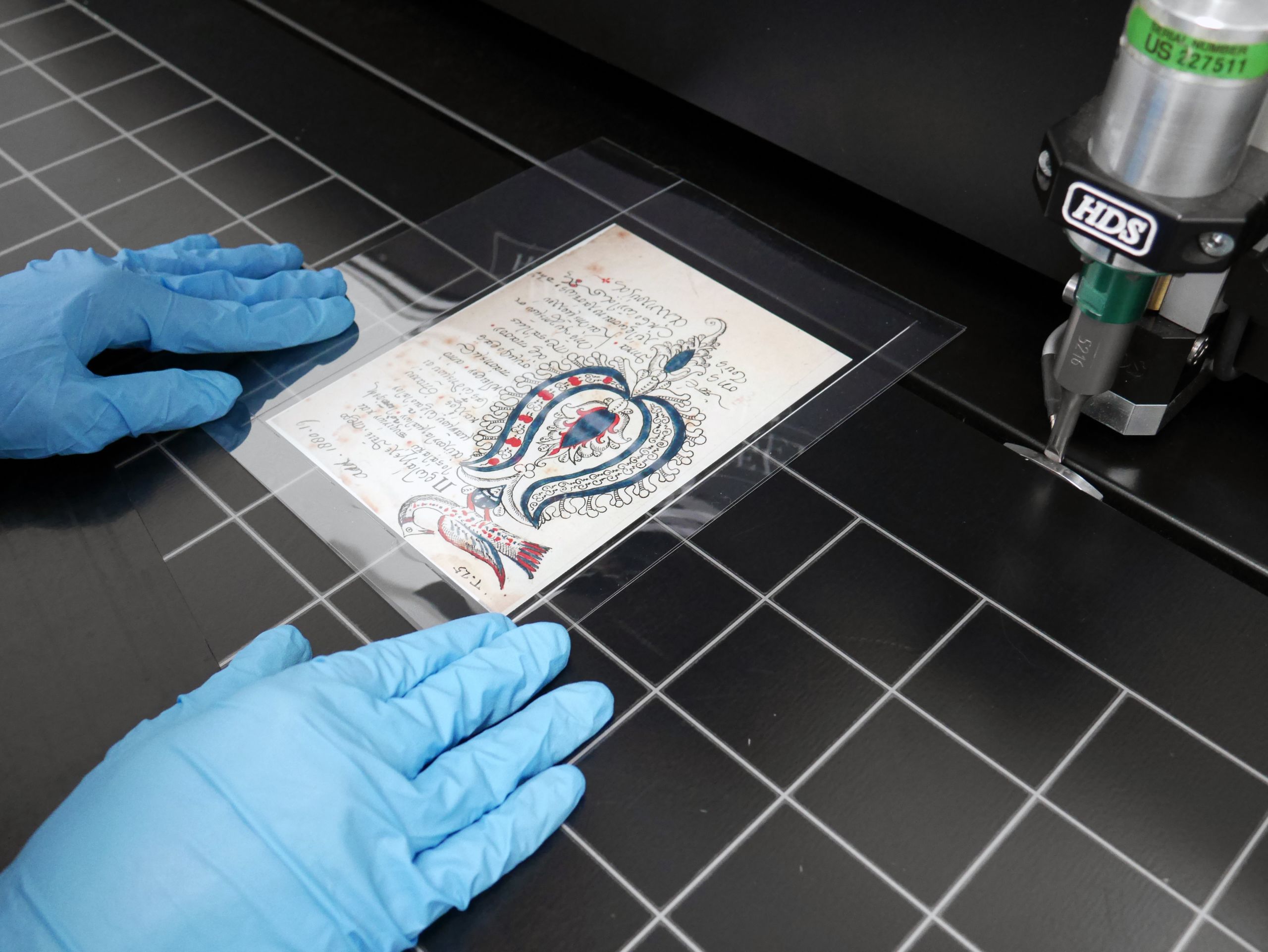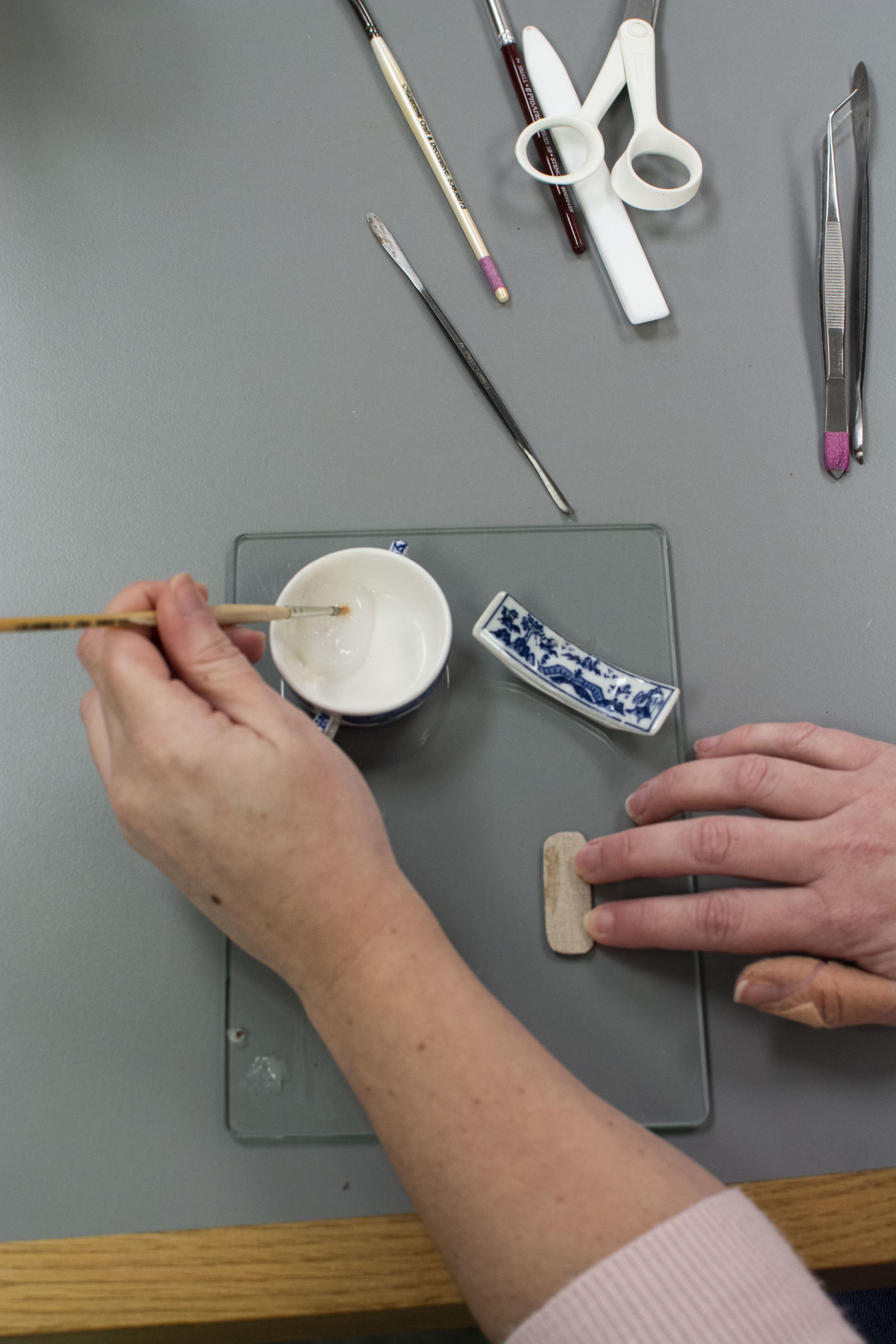Conservation Tools
What are the tools and materials involved in modern conservation?


Wheat Starch Paste
The most commonly used adhesive in the conservation department is wheat starch paste. It is a cellulose based adhesive, used often for paper repair. It’s essentially a refined version of flour paste, which has been used by bookbinders for hundreds of years.
Wheat starch paste is being applied to an aerolinen splint (aerolinen is a strong textile used in conservation). The pane of glass is used as a palette to make sure the right amount of paste is loaded into the brush before applying it to the splint and as an area for pasting out the repair.
Folders
These take their name from their function of folding or slitting paper.
In the conservation studio they are used for a variety of jobs, such as rubbing down materials to make sure they stick. We use both traditional bone, and modern Teflon folders.
Parchment
Parchment is made from animal skin which has been soaked in lime, de-haired, stretched on a frame, scraped to remove excess tissue and dried under tension.
This process produces a stiff, thin and strong material. Skins most often used for parchment are calf, goat or sheep skin. At the library we most often see it used as the pages or covering of a book.
The picture below shows a skin dried under tension on a wooden frame, known as a hearse.


A skin dried under tension on a wooden frame known as a hearse.
A skin dried under tension on a wooden frame known as a hearse.

Caecum
Caecum, sometimes known as goldbeaters’ skin, is prepared from the outer membrane of the large intestine of cattle. It is used in the conservation studio as a repair material for parchment. As parchment is made out of animal skin, they react similarly to temperature and moisture, making conservation easier.
The tool seen in the photo is a type of knife used to cut the caecum, it produces a soft edge that blends the repair pleasingly with the original parchment.
Carving Tools and Planes.
The craft of bookbinding involves skills borrowed from many other crafts and therefore so does conservation work. Sometimes, the wooden bookboards of a manuscript need to be replaced. These wooden boards are shaped with precision, and small imperfections will impact the finished book.
A sharp block-plane is used to shape and cushion bookboards. Hand carving tools are used to cut channels that accommodate the sewing structure. When working on Medieval Greek bindings the same tools are used to create the grooved edges of the board.


Humidification Chamber
Parchment can become stiff, folded and creased over time. Sometimes the manuscript is no longer readable because of this. When parchment is subjected to high humidity it becomes more supple and more easily manipulated, so creases and folds can be relaxed.
Parchment is very hydroscopic (absorbs water and moisture easily) so the process of humidification has to be done with extreme caution. A cedar wood humidification chamber with a breathable membrane is used to make the parchment easier to work with. Once it is supple enough, the parchment is removed from the chamber, manipulated to help reduce crease or folds and then dried under tension.


Japanese Paper
Japanese paper is the typical repair material used for paper manuscripts, books and documents. The paper can be very lightweight (as little as 2gsm) but is very strong for its weight. Japanese paper is handmade from vegetable fibres, typically Kozo, Gampi or Mitsumata plants. Kozo in particular is known for its long fibres that give the paper its strength.


The fineness of these papers along with their strength make them ideal for repairing old paper. Washi tape, popular for journaling and crafts, is a product inspired by the qualities and production processes of Japanese paper.
Microscope

A microscope is invaluable when the necessary repairs are imperceptible to the human eye. Centuries-old pigment (colouring material) can flake as the binder (glue) used to hold it to the surface of the page begins to fail. This flaking can result in the loss of pigment and eventually a whole illustration or illumination.
These flakes are minute, and so a steady hand, a tiny brush and a microscope are necessary. The process of pigment consolidation consists of introducing adhesive to the underside of the flaking pigment, drawing it back down and attaching it to the surface once again.
There is no audio on this short clip.
There is no audio on this short clip.
Native Dyed Goatskin
Native dyed goatskin is a type of tanned skin or leather. The skins come from Nigeria and are treated using traditional vegetable tanning and finishing techniques often centuries old and lost to most leather manufacturers.
This produces a skin with a natural grain pattern and slight variation in colour, which are near impossible to recreate with modern techniques. Native dyed goatskins have been used to cover the most recent re-bindings of Greek manuscripts in the conservation studio.


Paring knife and strop

A paring knife is an extremely sharp knife used to reduce the thickness of leather before it is used to cover a book or repair a book cover.
A leather strop polishes the knife and removes any burr on the blade, keeping it sharp. Here, an English paring knife is being sharpened using a strop in conjunction with a green polishing compound specifically for steel.

Paste Brushes
Paste brushes come in all shapes and sizes and, as the name suggests, are specifically designed for applying paste. A large paste brush can hold a lot of paste so is ideal for pasting out large areas like the covering leather seen in this photo.
Paste brushes are made from hog hair, a wooden handle and bound with string or a metal ferrule. The brush in the photo to the right has a copper ferrule.


Sewing Needles


Some may ask why a book conservator needs sewing needles. Before the mechanisation of the bookbinding process in the 19th century the leaves of books were sewn together by hand. This hand sewing can break down over time. Repairing sewing can be a tricky business and access to the sewing structure can be very restricted.
Conservators sometimes employ specially shaped or curved needles to reinstate sewing. Conservators also blunt the needles to avoid puncturing the old paper or parchment, preferring to use the holes made by the original binder. The photo shows Marina’s needle collection.
Suction table
The suction table is used by conservators to tackle difficult treatments of flat paper objects. The table has a perforated surface that allows air to be drawn through it, therefore creating suction. When an object, for example, a manuscript page, is placed on top of the table, it is gently pinned by the airflow to the table.
The table is designed to enable liquids to be drawn through the paper, and is often used for cleaning. In our case it was used for keeping a manuscript page flat and relatively stable, while Marina and Marie lined it with fine Japanese paper. The manuscript had been affected by mould, leaving the paper very soft and fragile. The paper was pre-coated with an adhesive that can be activated with ethanol.
The suction table helps in this process by keeping the object flat, drawing the very lightweight paper onto the object and drawing the ethanol through both lining and object, therefore reactivating the adhesive and creating a strong bond.



Ultrasonic Welder
Creating bespoke storage solutions for objects is often the final part of conservation treatment. The enclosures help protect the objects whether it is on the shelf or being used by readers. Flat objects can be encapsulated in Melinex, an archival grade polyester. To create this, the Melinex is welded together using ultrasonic vibration. The high frequency vibration generates heat energy that melts the Melinex just enough to be able to attach one piece to another.
The photo shows a manuscript leaf being welded into a Melinex encapsulation. Small holes are left in the welding to allow for air circulation. This casing will allow readers to handle the leaf while reducing the risk of mechanical damage and protecting it from dirt and dust.




